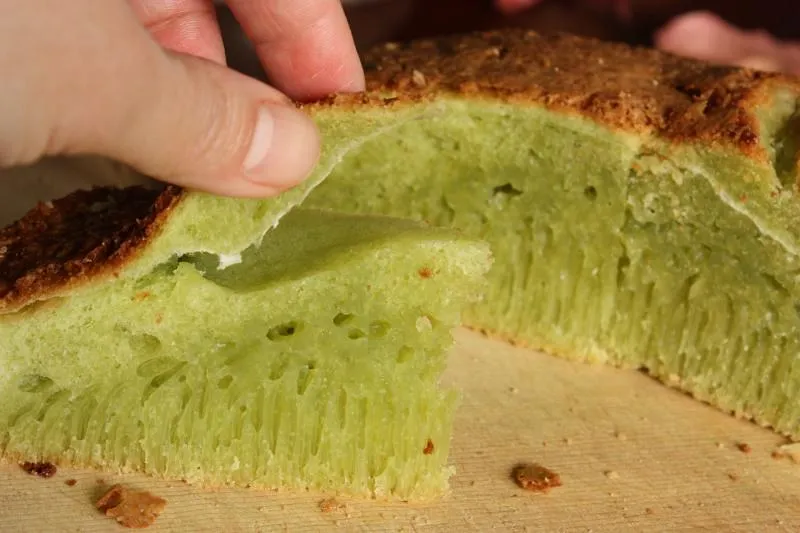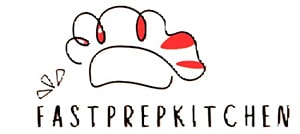The Best Fluffy Pancakes recipe you will fall in love with. Full of tips and tricks to help you make the best pancakes.
If you love sweet, chewy desserts with a hint of coconut and a beautiful honeycomb texture, Bánh Bò is about to become your new favorite treat. Also known as Vietnamese honeycomb cake, this traditional steamed dessert is famous for its light bounce, subtle pandan aroma, and signature airy interior. Made with rice flour, tapioca starch, coconut milk, and sometimes flavored with pandan, it’s a popular street food and celebratory dish across Vietnam.
In this post, you’ll learn everything you need to know to make authentic steamed Bánh Bò at home — from choosing the right ingredients to achieving the perfect rise and texture. Whether you’re new to Vietnamese desserts or rediscovering a childhood favorite, this recipe is simple, delicious, and totally satisfying.
Let’s dive into the world of chewy, fragrant, and irresistible Vietnamese cakes — one steamed slice at a time!
What Is Bánh Bò? A Sweet Vietnamese Delight
Bánh Bò is a beloved traditional dessert in Vietnamese cuisine, known for its light, airy texture and mild sweetness. The name translates roughly to “cow cake,” though it has nothing to do with cattle—the term “bò” refers to the cake’s unique springy texture, which “crawls” or expands like the movement of a cow, or more accurately, like something that breathes or rises.
This cake is prized for its chewy, honeycomb-like interior, which is formed by carefully fermenting a batter made from rice flour, tapioca starch, and coconut milk. Unlike Western cakes that rise in the oven, Bánh Bò is steamed, giving it a moist, spongy consistency and a glossy surface. It’s often infused with pandan extract, which gives the cake a beautiful green hue and fragrant floral aroma, though it also comes in white, yellow, or even pink versions.

Origins and Cultural Significance
Bánh Bò originated in southern Vietnam and is commonly found at street stalls, bakeries, and family gatherings. It’s a favorite for festivals, Lunar New Year celebrations (Tết), and offerings on altars. Its simple ingredients and festive appearance make it a symbol of abundance and comfort.
Unique Texture and Flavor
The hallmark of Bánh Bò is its elastic, bouncy texture with a network of tiny holes inside—similar to a honeycomb, hence the English name. This structure is the result of fermentation (usually with yeast or baking powder) and steaming. Flavor-wise, it’s lightly sweet, delicately coconutty, and incredibly fragrant when pandan is used.
Common Variations of Bánh Bò
- Bánh Bò Hấp: The most traditional form, steamed in small molds or a large pan.
- Bánh Bò Nướng: A baked version using a hot oven, yielding a caramelized crust and slightly firmer texture.
- Layered Bánh Da Lợn: Sometimes confused with Bánh Bò, this colorful, chewy layer cake uses similar ingredients but is structured differently.
- Flavored versions: Pandan, ube, or coffee can be added for both flavor and vibrant color.
When and How It’s Typically Served
Bánh Bò is often eaten as a snack or dessert, served plain or topped with grated coconut or sweet coconut cream. In Vietnamese homes, it’s offered with tea or as part of a dessert tray during celebrations. Thanks to its gluten-free ingredients and nostalgic value, it remains a cross-generational favorite.
Ingredients You’ll Need for Vietnamese Honeycomb Cake
To make an authentic Vietnamese Bánh Bò, the magic lies in just a few simple, pantry-friendly ingredients. Each component plays a key role in creating the cake’s unique honeycomb texture, soft chewiness, and signature coconut-pandan flavor. Below is a breakdown of the essential ingredients, along with tips and possible substitutions.
🥥 Key Flours: Rice Flour & Tapioca Starch
- Rice flour is the foundation of Bánh Bò, giving it its delicate and slightly chewy texture.
✅ Tip: Use regular white rice flour—not glutinous rice flour (sweet rice flour), which will make the cake too dense. - Tapioca starch is added to increase elasticity and bounce, helping to form the signature honeycomb pattern during steaming.
✅ Tip: Look for tapioca starch in Asian markets or substitute with cassava flour if needed.
🍬 Sweet and Fragrant: Sugar, Coconut Milk & Pandan Extract
- Granulated sugar provides the sweetness and helps feed the yeast (if using). You can adjust the sugar slightly to taste.
- Coconut milk adds rich, creamy flavor and moistness. It’s one of the defining flavors of Vietnamese desserts.
✅ Tip: Use full-fat canned coconut milk for best results—avoid light or diluted versions. - Pandan extract (or fresh pandan juice) gives the cake its signature floral aroma and green color.
✅ Alternative: If you can’t find pandan, vanilla extract can be used, but the flavor will be different and less authentic.
🧪 Leavening Agents: Yeast or Baking Powder?
The cake’s honeycomb structure relies on proper leavening. You can use either:
- Active dry yeast – Ferments the batter over time, producing tiny air pockets for that iconic structure.
✅ Tip: Allow at least 1–2 hours of proofing to build up the bubbles. - Double-acting baking powder – A quicker option that creates lift during mixing and steaming.
✅ Note: Yeast is more traditional and gives a slight fermented aroma, while baking powder offers a milder, cleaner taste.
Some recipes even use a combination of both for reliable results.
🧂 Optional Add-ins and Substitutes
- Warm water or coconut water – Used to dissolve sugar and activate yeast.
- Salt – A pinch balances the sweetness and enhances flavor.
- Food coloring – If not using pandan, you can still add green or other natural food coloring for a vibrant look.
- Grated coconut – Optional, for sprinkling on top when serving.
- Fresh pandan leaves – If available, blend with water and strain to make your own pandan juice instead of extract.
With these ingredients in hand, you’re ready to create a truly authentic and aromatic Bánh Bò that’s just like the ones found in Vietnamese bakeries and family kitchens. Up next: how to bring it all together step by step.
Step-by-Step Instructions to Make Steamed Bánh Bò
Making Bánh Bò may seem intimidating at first, but once you understand the process, it’s actually quite simple. The key to success is patience, proper fermentation, and gentle steaming. Follow these step-by-step instructions to get the perfect chewy, airy honeycomb texture every time.

🔪 Step 1: Prepare the Coconut Syrup
Start by making a warm syrup using coconut milk and sugar.
- In a saucepan, combine 1 cup (200 g) of sugar and 1 can (13.5 oz / 400 ml) of full-fat coconut milk.
- Optionally, add 2–3 tablespoons (30–45 ml) of water to thin slightly.
Heat gently over low-medium heat, stirring until the sugar is completely dissolved.
Do not boil—you just want the mixture warm enough to activate the yeast later.
Let it cool to lukewarm (about 95–104°F / 35–40°C) before use.
✅ Tip: If using pandan extract or fresh pandan juice, add 1–2 teaspoons now for even flavor distribution.
🥣 Step 2: Mix the Dry Ingredients
In a large bowl:
- Sift together 1 cup (120 g) of rice flour and 1/2 cup (65 g) of tapioca starch.
- Add 1/4 teaspoon of salt to enhance the flavor balance.
✅ Tip: Sifting removes lumps and incorporates air for a lighter texture.
🧪 Step 3: Activate the Yeast (if using)
- In a small bowl, dissolve 2 teaspoons of active dry yeast in about 1/4 cup (60 ml) of the lukewarm coconut syrup.
- Let it sit for 5–10 minutes, or until it becomes frothy and bubbly.
✅ Tip: If using 1 tablespoon of double-acting baking powder instead, add it directly in Step 4 (no activation needed).
🥄 Step 4: Combine and Rest the Batter
- Gradually pour the coconut syrup (with yeast) into the flour mixture, stirring continuously until you get a smooth, pourable batter (like pancake batter).
- Cover the bowl with plastic wrap or a clean kitchen towel.
- Let it rest in a warm spot for 1.5 to 2 hours, until bubbles form and the batter increases slightly in volume.
✅ Tip: A turned-off oven with the light on or a sunny windowsill works well.
🍽️ Step 5: Steam the Cake
- Prepare your steamer and bring water to a boil.
- Grease a heatproof cake pan (6 to 8 inches) or small ramekins with neutral oil.
- Stir the batter gently (don’t deflate the bubbles) and pour into the mold(s).
- Tap lightly to release large air pockets.
- Cover with a lid wrapped in a towel to prevent water droplets from falling on the batter.
- Steam over medium-high heat for 20–30 minutes, depending on mold size.
✅ Tip: Do not open the lid for the first 15–20 minutes to prevent collapse.
🔪 Step 6: Cool and Serve
- Remove the cake from the steamer and allow it to cool completely in the pan.
- Once cool, unmold carefully and slice with an oiled knife to reveal the beautiful honeycomb texture.
✅ Serving suggestion: Enjoy plain, or top with grated fresh coconut or a drizzle of sweetened coconut cream.
Tips for Getting the Perfect Honeycomb Texture
The hallmark of a great Bánh Bò lies in its light, chewy texture with visible honeycomb-like air pockets throughout the cake. Achieving this texture requires attention to a few key details—especially during the fermentation and steaming process. If your cake turns out dense or flat, one of these steps is likely the culprit. Here are the best tips to ensure that signature “bò” bounce and honeycomb structure.
🍯 1. Let the Batter Ferment Properly
- Fermentation is the most crucial step. It’s what creates the natural air bubbles that form the honeycomb interior.
- Use active dry yeast and allow the batter to rest in a warm environment for 1.5 to 2 hours until bubbly and slightly risen.
- If the environment is too cold, the yeast won’t activate properly. Too hot, and it might over-proof or die.
✅ Tip: Look for lots of small bubbles on the surface—that means it’s ready.
⚖️ 2. Maintain the Right Batter Consistency
- The batter should be smooth and pourable—not too thick or too watery.
- Too thick = dense cake with no air pockets.
- Too thin = structure may collapse or become rubbery after steaming.
✅ Tip: The ideal texture is somewhere between crepe and pancake batter.
💨 3. Use a Lid with a Towel When Steaming
- Cover your steamer lid with a clean kitchen towel to prevent water droplets from dripping onto the cake.
- Excess moisture can affect the cake’s ability to rise evenly and interfere with the formation of the honeycomb texture.
✅ Tip: Keep the steamer lid closed for at least the first 15–20 minutes to avoid sudden temperature changes.
🔥 4. Steam at the Right Temperature
- Steaming should be done at medium to medium-high heat.
- Too much heat can cause the cake to bubble unevenly or cook too quickly on the outside, while the inside stays undercooked.
- Too little heat might not give the batter enough lift.
✅ Tip: Make sure the water is boiling before placing the batter inside the steamer.
🧪 5. Use Fresh Leavening Agents
- Whether you use yeast, baking powder, or a combination, make sure your ingredients are fresh and active.
- Expired yeast or baking powder won’t provide enough gas to create the iconic bubbles.
✅ Tip: Always test your yeast by activating it with warm liquid and sugar first—if it foams, it’s alive!
🚫 Bonus: Avoid These Common Mistakes
- Skipping fermentation or under-proofing = no honeycomb texture
- Opening the steamer too early = sunken center
- Over-mixing after fermentation = deflates the bubbles
- Using glutinous rice flour = too dense and gummy
Serving Ideas and Variations to Try
Once you’ve mastered the art of making Bánh Bò, the fun really begins! This soft, fragrant Vietnamese honeycomb cake can be enjoyed in a variety of ways—from traditional serving styles to creative modern twists. Whether you want to keep it classic or explore new flavors, these serving ideas and variations will help you enjoy Bánh Bò to the fullest.
🍵 Traditional Ways to Serve Bánh Bò
- Served plain and warm: Freshly steamed Bánh Bò is often served warm, cut into diamond or square shapes, and eaten as a simple, comforting treat.
- Topped with grated coconut: In Vietnam, it’s common to sprinkle fresh or lightly salted shredded coconut on top. The salty-sweet combo enhances the flavor beautifully.
- With a side of hot tea: Enjoy it as a light afternoon snack paired with jasmine tea or lotus tea, balancing the richness of the coconut milk.
- As part of a dessert platter: Bánh Bò is often included in Vietnamese dessert assortments (Chè or bánh trays) for festivals, weddings, or Lunar New Year celebrations.
✅ Tip: Serve the cake on banana leaves for a more authentic and aesthetic presentation.
🌈 Flavor Variations: Pandan, Coffee, Ube & More
While traditional Bánh Bò Hấp is usually white or light green from pandan, you can infuse it with a variety of flavors and colors:
- Pandan (green): The classic and most popular version with floral aroma and vibrant green hue.
- Ube (purple yam): A trendy twist with a sweet, nutty flavor and stunning purple color.
- Coffee or mocha: Add a tablespoon of instant coffee or espresso powder for a rich, earthy take.
- Coconut caramel (Bánh Bò Nướng): A baked version with deeper caramel flavor and crispy edges.
✅ Note: Use natural flavor extracts or real purées to keep the texture consistent.
🔥 Bánh Bò Nướng: The Baked Honeycomb Cake
- This variation swaps steaming for baking, creating a golden crust and firmer texture.
- It often uses baking powder and coconut caramel syrup, and is baked in the oven until puffed and lightly browned.
- Bánh Bò Nướng has a more robust flavor, often served during special occasions or shared with guests.
✅ Serving idea: Dust lightly with powdered sugar or top with sesame seeds before baking for a nutty touch.
🌱 Make It Vegan or Gluten-Free
Good news—Bánh Bò is naturally gluten-free since it uses rice and tapioca flours! It’s also easy to make vegan:
- Use plant-based sugar and coconut milk with no added dairy.
- Ensure your yeast is vegan-friendly (some types are processed with animal products).
- For a richer vegan version, drizzle with coconut cream and roasted peanuts.
✅ Bonus tip: Add a pinch of turmeric or saffron for color without artificial additives.





